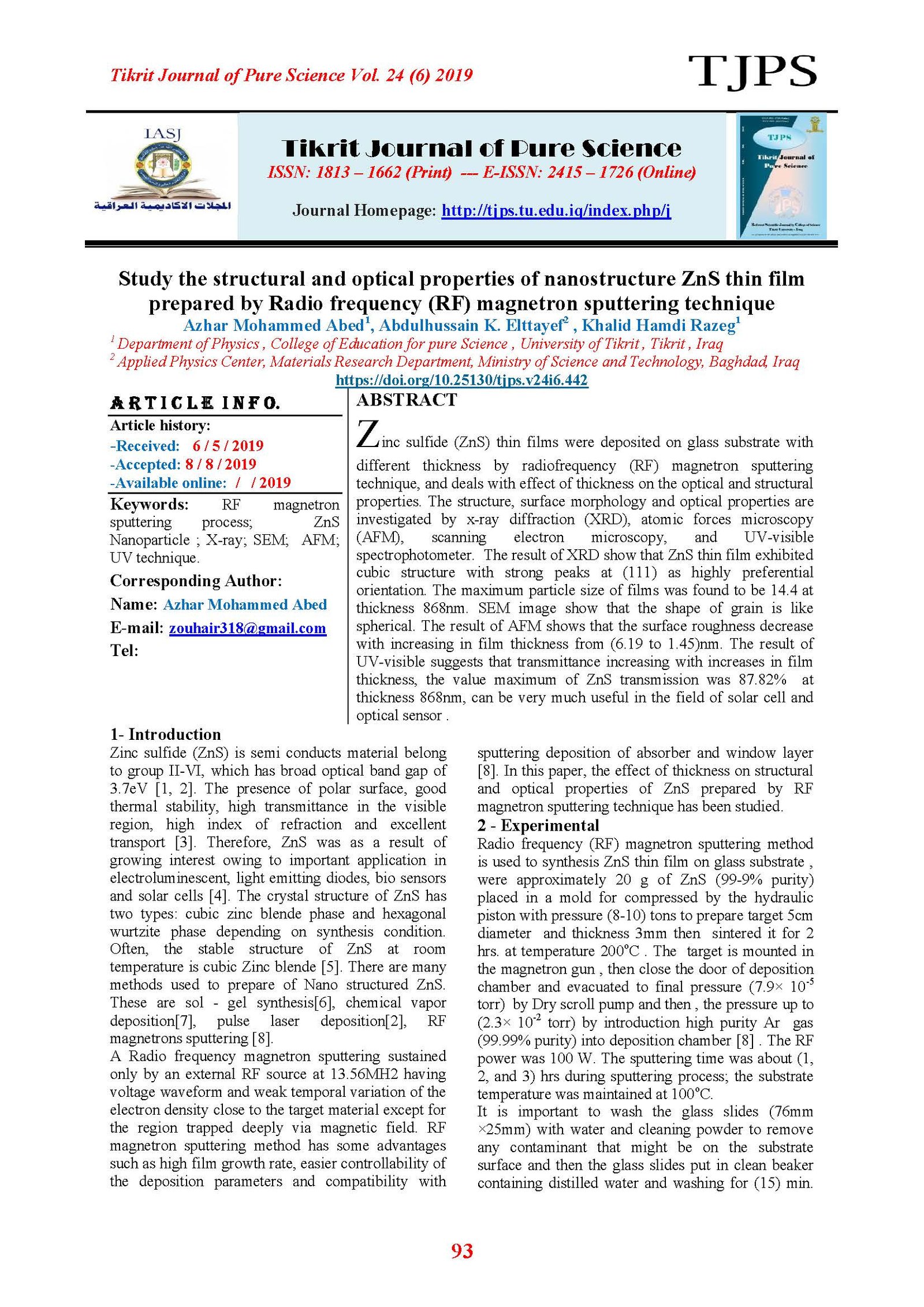Study the structural and optical properties of nanostructure ZnS thin film prepared by Radio frequency (RF) magnetron sputtering technique
Main Article Content
Abstract
Zinc sulfide (ZnS) thin films were deposited on glass substrate with different thickness by radiofrequency (RF) magnetron sputtering technique, and deals with effect of thickness on the optical and structural properties. The structure, surface morphology and optical properties are investigated by x-ray diffraction (XRD), atomic forces microscopy (AFM), scanning electron microscopy, and UV-visible spectrophotometer. The result of XRD show that ZnS thin film exhibited cubic structure with strong peaks at (111) as highly preferential orientation. The maximum particle size of films was found to be 14.4 at thickness 868nm. SEM image show that the shape of grain is like spherical. The result of AFM shows that the surface roughness decrease with increasing in film thickness from (6.19 to 1.45)nm. The result of UV-visible suggests that transmittance increasing with increases in film thickness, the value maximum of ZnS transmission was 87.82% at thickness 868nm, can be very much useful in the field of solar cell and optical sensor .
Article Details

This work is licensed under a Creative Commons Attribution 4.0 International License.
Tikrit Journal of Pure Science is licensed under the Creative Commons Attribution 4.0 International License, which allows users to copy, create extracts, abstracts, and new works from the article, alter and revise the article, and make commercial use of the article (including reuse and/or resale of the article by commercial entities), provided the user gives appropriate credit (with a link to the formal publication through the relevant DOI), provides a link to the license, indicates if changes were made, and the licensor is not represented as endorsing the use made of the work. The authors hold the copyright for their published work on the Tikrit J. Pure Sci. website, while Tikrit J. Pure Sci. is responsible for appreciate citation of their work, which is released under CC-BY-4.0, enabling the unrestricted use, distribution, and reproduction of an article in any medium, provided that the original work is properly cited.
References
[1] Nabiyouni, G. et al.(2011). Preparation and characterization of nano structured ZnS thin films grown on glass and N- type Si substrates. Review of Advanced Material Science, 27:52-57.
[2]- Ikhioya, I. L. (2015). Characterization of zinc sulphide thin film prepared by electrodeposition method. International Journal of Chemtech Research, 8 ( 2): 655-660.
[3]- Sadoon, A. and Sharma, R. (2016). Structural, morphological, optical and electrical properties of Nano structured Zn MnS thin film prepared by chemical bath deposition method. International Journal of Pure and Applied Physics, 12(1):1-8.
[4]- Wauy, C. F.; Li, Q.S. and Wang, T.S. (2016). White light emission from Zns: Mn thin films deposited on GaN substrates by pulsed laser deposition . China Physics Letter, 33 (7):1-4.
[5]- Laporta, F.A. et al. (2014). Zinc blende versus wurtzite nanoparticles: control of the phase and optical properties by tetra butylammonium hydroxide. Physical Chemical. Chemical Physical, 16: 1-11.
[6]Tian, J. et al. (2009). Photocatalyst of TiO2-ZnO Nano Composite Film: Preparation, Characterization and Photodegradation Activity of Methyl Orange. Surface and Coatings Technology, 204(3): 205-214.
[7] Wu, X. et al. (2008). Optical inhomogeneity of ZnS films deposited by thermal evaporation . Applied Surface Science, 254 (20): 6455-6460.
[8]- Kong, L.; Deng, J. and Chen, L. (2017). Structural and optical characterization of magnetron sputtered Zns thin films annealed in different atomshere . Chalcogenide letters, 14 (3): 37-96.
[9]- Pandya, S. G. (2016). Structural, optical and electrical properties of chemically deposited zinc sulphide thin films. International Journal of Recent Scientific Research, 7(12): 14700-14703.
[10]- Bioki, H. A. and Zarandi, M. B. (2011). Effects of annealing and thickness on the structural and optical properties of crystalline ZnS thin films prepared by PVD method. International Journal of Optics and photonics, 5 (2) : 121-127.
[11] Priya, K.; Gowrish K. R. and Ganesh, S. (2018). Effect of deposition parameters on structural and optical properties of ZnS thin films. Second International on Materials Science and Technology, 360:1-6.
[12]- Ahn, H. and Uw, Y. (2015). Post-annealing effects on ZnS thin films grown by using the CBD method. Journal of the Korean Physical society, 67(6): 1045-1050.
[13]- Vishwakarma, R.(2017). Thickness– dependent structural, electrical, and optical properties of ZnS thin film deposited by thermal evaporation. Ukrainian Journal of Physics, 62 ( 5) : 422-431.
